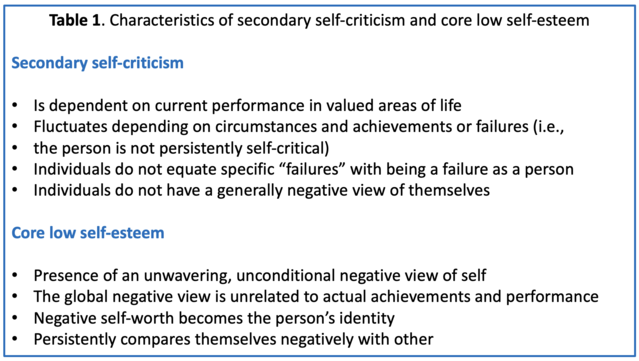Self-Esteem
Low Self-Esteem and Eating Disorders
What to do when the two problems coexist.
Posted April 2, 2022 Reviewed by Vanessa Lancaster
Key points
- Some people with eating disorders have an unconditional and pervasive poor opinion of their self-worth.
- Because it is long-lasting and does not seem to depend on circumstances or performance, it is called core low self-esteem.
- When core low self-esteem coexists with the eating disorder, it obstructs change and should be addressed by the treatment.
Some people with an eating disorder have additional pronounced psychological issues that contribute to maintaining their eating disorder and interfere with treatment.
One of the most common co-occurring psychological problems is low self-esteem. However, to optimize the treatment, it is important to understand if the reported negative self-evaluation is secondary to the eating disorder or independent of it.
Secondary Self-Criticism Versus Core Low Self-Esteem
Most people with an eating disorder are highly self-critical as a result of their perceived failure to achieve their shape, weight, and eating control goals. This is a form of negative self-evaluation that can be described as “secondary” self-criticism because it occurs as a result of something else. This aspect of negative self-evaluation does not need to be addressed by treatment because it generally does not obstruct it and, in fact, improves spontaneously once the eating disorder is successfully treated.
Some people, however, have underlying extremely low self-esteem, characterized by an unconditional and pervasive poor opinion of their self-worth. Because this is long-lasting and does not seem to depend on circumstances or performance, we call it core low-self-esteem.
People with core low self-esteem believe that they have little or no value as individuals and describe themselves as being “worthless,” “useless,” “stupid,” “unlovable,” and/or “a failure.” They also tend to make negative comparisons with others (“She/he/everyone is so much better/thinner/ more intelligent than I”).
Other specific features of core low self-esteem are pessimism—an extremely negative view of the future—and hopelessness—the belief that positive change is impossible. We call these attitudes “negative cognitive biases,” which tend to undermine the treatment.
Table 1 describes how to distinguish secondary self-criticism from core low self-esteem.

Core low self-esteem is also a risk factor for the development of anorexia nervosa or bulimia nervosa. Furthermore, it is always long-lasting, and its onset is difficult to determine.
When core low self-esteem coexists with the eating disorder, it obstructs change through two main processes:
- Individuals see little or no prospect of recovery as a result of the unconditional and pervasive nature of their negative view of themselves.
- The presence of core low self-esteem leads individuals to strive especially hard to control their shape, weight, and eating in an attempt to overcome their sense of worthlessness.
With core low self-esteem, the chances of treatment success are poor unless low self-esteem is directly addressed.
Addressing Core Low Self-Esteem
Enhanced cognitive behavior therapy (CBT-E), an evidence-based treatment for all eating disorders of adults and adolescents, addresses core low self-esteem in two ways:
- Directly with cognitive-behavioral procedures (Fennell, 2016).
- Indirectly by enhancing interpersonal functioning.
If a patient has obvious cognitive biases, it is best for core low self-esteem to be addressed directly, but the indirect method may be more suitable if it seems feasible to create a self-sustaining network of positive interpersonal relationships.
If the indirect method is selected, it is explained that in the therapist’s opinion, the best way of improving patients’ self-esteem would be to enhance the quality of their relationships. On the other hand, if the direct method is chosen, core low self-esteem should be addressed using standard cognitive-behavioral strategies and procedures. As with the other additional modules of CBT-E, it should be addressed alongside eating-disorder psychopathology, allocating half of the agenda time to each.
In any case, change in self-esteem is usually facilitated by a change in other areas, such as the amelioration of eating-disorder psychopathology or improved interpersonal functioning.
To find a therapist, visit the Psychology Today Therapy Directory.
References
Dalle Grave R, Sartirana M, Calugi S. Complex cases and comorbidity in eating disorders. Assessment and management. Cham, Switzerland: Springer Nature; 2021.
Fairburn CG, Cooper Z, Shafran R, Bohn K, Hawker DM. Clinical perfectionism, core low self-esteem and interpersonal problems. In: Fairburn CG, editor. Cognitive behavior therapy and eating disorders New York: The Guilford Press; 2008. p. 197-221.
Fennell MJ. Overcoming low self-esteem: A self-help guide using cognitive behavioural techniques 2nd ed. London: Constable & Robinson; 2016.


